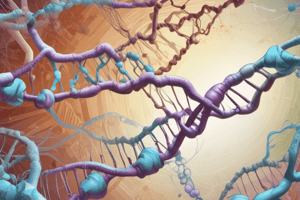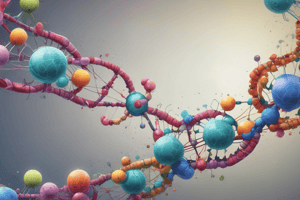Podcast
Questions and Answers
Messenger ______ are the key intermediates in the process of gene expression.
Messenger ______ are the key intermediates in the process of gene expression.
RNAs
The process of ______ is the first step in gene expression, involving the conversion of DNA into RNA.
The process of ______ is the first step in gene expression, involving the conversion of DNA into RNA.
transcription
During ______ processing, introns are removed and exons are joined into mature mRNAs.
During ______ processing, introns are removed and exons are joined into mature mRNAs.
mRNA
Mutations can affect ______ synthesis, processing, and translation.
Mutations can affect ______ synthesis, processing, and translation.
Single nucleotide missense substitutions can mediate ______ initiation.
Single nucleotide missense substitutions can mediate ______ initiation.
Genetic information encoded in DNA is translated into functional ______.
Genetic information encoded in DNA is translated into functional ______.
Transcription is initiated when an RNA ______ binds to a promoter sequence on the DNA molecule.
Transcription is initiated when an RNA ______ binds to a promoter sequence on the DNA molecule.
The genetic code is based on the complementarity between the four nucleotide bases in DNA and the ______ amino acids in proteins.
The genetic code is based on the complementarity between the four nucleotide bases in DNA and the ______ amino acids in proteins.
Ribosomes contain proteins and specialized RNA molecules, such as ______ RNA (rRNA) and transfer RNA (tRNA), which are adaptor molecules.
Ribosomes contain proteins and specialized RNA molecules, such as ______ RNA (rRNA) and transfer RNA (tRNA), which are adaptor molecules.
Binding of regulatory proteins to an enhancer sequence causes a shift in ______ structure that either promotes or inhibits gene transcription.
Binding of regulatory proteins to an enhancer sequence causes a shift in ______ structure that either promotes or inhibits gene transcription.
Mutations that affect ______ splicing, such as the splicing donor site mutation in the ENAM gene, can cause rare genetic conditions.
Mutations that affect ______ splicing, such as the splicing donor site mutation in the ENAM gene, can cause rare genetic conditions.
Defects in ______ initiation can cause developmental cognitive and behavioral disorders, such as X-linked adrenoleukodystrophy and adrenomyelomyopathy.
Defects in ______ initiation can cause developmental cognitive and behavioral disorders, such as X-linked adrenoleukodystrophy and adrenomyelomyopathy.
Flashcards are hidden until you start studying
Study Notes
Gene Expression
Gene expression is a crucial aspect of biology, involving the steps through which genetic information encoded in DNA is translated into functional proteins. These proteins play a vital role in various cellular processes, including cell growth, differentiation, and response to environmental conditions. The process of gene expression involves several interconnected steps, with messenger RNAs (mRNAs) being the key intermediates.
mRNA Processing
The precursor mRNA is transcribed from template DNA and undergoes a series of processing steps. These steps include 5' end-capping, 3' end-polyadenylation, and splicing, which remove introns (non-protein-coding sections) and join exons (protein-coding sections) into mature mRNAs. The newly formed mature mRNAs are then exported to the cytoplasm, where they can be translated, stored, or degraded.
Mutagenesis
Mutations can affect mRNA synthesis, processing, and translation. For example, single nucleotide missense substitutions at the translation initiation codon of the human LDL receptor gene (LDLR) can mediate translation initiation, although they lead to different levels of impairment on LDLR expression and activity, demonstrating different efficiencies of the translation initiation at the resulting non-canonical initiation codons.
Transcription
Transcription is the first step in gene expression, involving the conversion of DNA into RNA. It occurs in the nucleus of eukaryotic cells and is initiated when an RNA polymerase binds to a promoter sequence on the DNA molecule. Some regulatory proteins can affect transcription by binding to enhancer sequences, which provide binding sites for regulatory proteins that affect RNA polymerase activity. Binding of regulatory proteins to an enhancer sequence causes a shift in chromatin structure that either promotes or inhibits gene transcription.
Genetic Code
The genetic code is the set of rules that dictates how the sequence of nucleotides in DNA and RNA determines the sequence of amino acids in proteins. It is based on the complementarity between the four nucleotide bases in DNA and the 20 amino acids in proteins. This code is universal across all life forms, with slight variations in the genetic code among different species.
Translation
Translation is the second major step in gene expression, where the information in the mature mRNA is used to produce a protein. It occurs in the cytoplasm of eukaryotic cells and is facilitated by ribosomes, which are composed of two subunits: the large (50S) subunit and the small (30S) subunit. Ribosomes contain proteins and specialized RNA molecules, such as ribosomal RNA (rRNA) and transfer RNA (tRNA), which adaptor molecules that can read the triplet code in the mRNA and translate it into the corresponding amino acid sequence.
Genetic Disorders
Genetic disorders can arise from mutations or changes in the genetic code that lead to abnormal gene expression. For example, defects in translation initiation can cause developmental cognitive and behavioral disorders, such as X-linked adrenoleukodystrophy and adrenomyelomyopathy due to the use of downstream initiation codons that lead to the generation of aberrant shortened proteins. Additionally, mutations that affect mRNA splicing, such as the splicing donor site mutation in the ENAM gene, can cause rare genetic conditions like hypoplastic amelogenesis imperfecta, which affects tooth enamel.
Studying That Suits You
Use AI to generate personalized quizzes and flashcards to suit your learning preferences.




